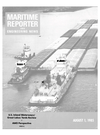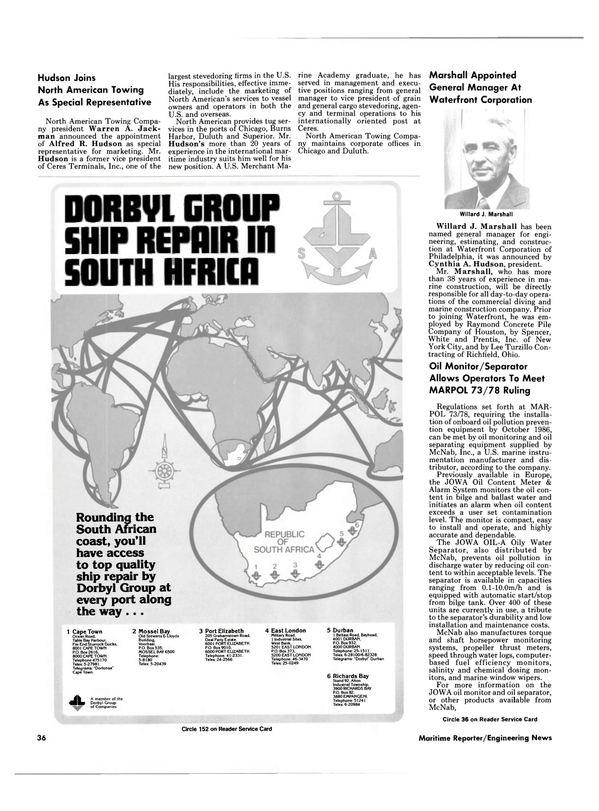
Luxury Cruise Liner 'Holiday' Delivered By Aalborg Shipyard
The 46,052-grt luxury cruise liner Holiday (shown above on sea trials) has been delivered by Aalborg Vaerft in Denmark to Carnival Cruise Lines Inc. of Panama. She is designed and built as a steel-hulled, twin-screw/rudder, passenger cruise ship with raked stem, transom stern, bulbous bow, bow and stern thrusters, and fin stabilizers.
The liner has an overall length of about 727 feet, beam of 91.86 feet, depth to upper deck of 69 feet, and design draft of 24.6 feet. A total of 716 standard cabins are arranged on decks 4, 5, 6, and 7, and 10 deluxe verandah suites are located on deck 11 forward. Total passenger capacity is 1,794; the ship carries a crew of 646 persons.
The main propulsion plant comprises two Sulzer low-speed diesel engines, type 7 RLB 66, with integral thrust bearing, each coupled directly to a KaMeWa controllablepitch propeller with highly skewed blade design. The main engines each have a maximum continuous rating of 15,770 bhp at 140 rpm.
The Siemens propulsion control system, which includes automatic main engine overload control as well as an engine load increase feature, incorporates different operating modes, including: constant-speed operating mode at 136 rpm for shaft alternator operation; and two combination operating modes—one thrust mode and one pitch mode— where the engine speed, propeller thrust, and propeller pitch are controlled according to a pre-established curve.
Normally at sea, the ship will be operated in the constant-speed mode at 136 rpm, and the shaftdriven alternators will feed the main switchboard. As it is not the intention to run the two shaft alternators in parallel, the main switchboard is capable of being operated in a "split" mode by means of a section breaker on the bus bar. In this mode each alternator will feed half of the main switchboard.
The vessel's hull form has been developed to give good propulsion and seakeeping performance with due regard to large propeller tip clearance requirements at the various design conditions. The lines have been designed to give the smallest possible resistance, with the bulbous bow designed for a draft of 24.6 feet and optimized for a service speed of 19.5 knots.
Comprehensive model tank experiments were carried out at the Danish Ship Research Laboratory, including maneuvering, steering, seakeeping, and berthing tests. The vessel is provided with stern fins designed to optimize the water flow to the propellers for further reduction of vibration and noise levels.
The basic hull, the hull superstructure, the funnel, and the masts are made completely of mild steel as a fully welded structure corresponding to the requirements of Lloyd's Register of Shipping + 100A1. The entire steel structure of the vessel, in particular the aft body section, has been carefully designed to be free from vibration that might disturb the comfort of the passengers and the crew. Exciter tests were carried out at an early stage of outfitting to confirm the calculated natural frequencies of the primary structure and panels.
The accommodation areas of approximately 40,000 square meters have been designed in accordance with Aalborg Vaerft's modular system, insuring high quality in the assembling of the components on board during construction as well as easy maintenance during the lifetime of the ship. To insure optimal design of the passenger cabins, a full-size mockup of an inside and an outside cabin, including shower and toilet units and a section of the adjacent corridor, were made at an early stage.
Generally, all linings and divisional bulkheads in the passenger and crew cabins, living quarters, and service rooms are 50-mm thick.
The core material is non-toxic rockwool composition faced with 0.7- mm, PVC-covered galvanized steel plate. In other public spaces, linings and divisional bulkheads are of the same nature, with special attention to the decorative aspects.
Except for certain parts of the public spaces, where special features are introduced, Dampa continuous ceiling systems, consisting of prestressed, baked enamel steel/aluminum panels, are used throughout the accommodations. Sound-absorbing decks consisting of mineral wool slabs with steel top are installed in the crew accommodations above the engine rooms as well as below the bandstand and dance floors to provide maximum insulation against noise.
The special funnel design developed for the cruise ship Tropicale, delivered to Carnival Cruise Lines by Aalborg Vaerft in 1981, is also used on the Holiday. Also, the totally enclosed wheelhouse design extending from side to side with panoramic windows all around is another feature transferred from the Tropicale.
The Holiday is a typical example of the products from the Ship Division of Aalborg Vaerft—a highly complex passenger vessel of the most advanced design and comprising the latest technology, purposebuilt to insure full compatibility with the requirements of the owner.
Read Luxury Cruise Liner 'Holiday' Delivered By Aalborg Shipyard in Pdf, Flash or Html5 edition of August 1985 Maritime Reporter
Other stories from August 1985 issue
Content
- Houston Ship Repair Reactivates 40-Year-Old Hattiesburg Victory page: 5
- Cybernet Introduces Multi-Scan, High-Tech VHF-FM Radiotelephone page: 5
- Navy Announces Homeport Sites In Gulf Coast Area page: 5
- Hunt Associates And Gladding-Hearn Collaborate On Pilot Boat Design page: 6
- Johnson-Duramax Stuffing Boxes Make Packing Changes Easier page: 6
- Versatile FPSO Manifold System Eliminates Fluid Swivels page: 7
- Consolidation Of Chevron And Gulf Fleets Announced page: 7
- Murdock Engineering Introduces New Tension System Design page: 7
- Joseph Cuneo Elected Board Chairman & CEO Of J.J. Henry Co., Inc. page: 8
- Jeffboat Delivers River Towboat M/V Cletus To Luhr Brothers page: 8
- Reagan Nominates Navy's First Space And Warfare Systems Commander page: 8
- Total Transportation Systems Acquires Kenmark page: 8
- New Navigation System From Odin Electronics page: 8
- Free Brochure On Piston And Plunger Pumps From Cat Pumps page: 9
- Aluminum Boats, Inc. Delivers 'Abeer Nine' To Saudi Arabia page: 10
- Unique Controllers Operate Cargo Area HVAC System On New MPS page: 10
- Pfeiffer And Military Sealift Command To Receive AOTOS Awards page: 11
- Great Lakes International To Spend Over $30 Million On Dredge —Bids To Be Taken On Another page: 11
- Halter Delivers Rocket Booster Recovery Vessel 'Independence' page: 11
- Australia Plans To Build Diesel-Electric Submarines Of European Design page: 11
- Arnessen Offers Full-Color Brochure On Atlas-Danmark Freshwater Generators page: 11
- COAST GUARD USER TAXES: UNTIMELY AND UNWISE page: 12
- 'FUEL SAV-R —New Fuel Monitor From National Control Systems page: 12
- Wartsila Vasa 32 Engine In Demand For New Generation Drilling Rigs page: 12
- Wartsila-Normed Joint Venture To Manufacture Diesels In France page: 13
- General Electric To Supply Machinery Control System For Navy Destroyer Burke page: 14
- Racai Wins Contract From State Of Louisiana For Marine Simulator page: 14
- Unitor Announces Two N e w Services For Marine Refrigeration page: 15
- Pettit Paint Expands Antifoulings Market Base page: 15
- NASSCO Announces Three Key Executive Appointments page: 16
- OFFSHORE EUROPE 85 Exhibition & Conference page: 16
- INLAND WATERWAYS/ GREAT LAKES YARDS Review page: 18
- Omnipure Opens New Headquarters And Plant In Sugar Land, Texas page: 26
- Siess Will Chair NOIA's Pro-Leasing Task Force page: 26
- W i l l i am M. Lechler Joins Sumitomo Machinery Corp. page: 28
- Anderson Named President Of Raytheon Marine European Operations page: 28
- NMEA Annual Meeting To Be Held October 13-15 In Seattle page: 29
- Manitowoc Announces Six New Personnel Additions At Manitex Subsidiary page: 29
- Great Lakes Firm Offers Extensive Inventory Of Marine Equipment Spare Parts page: 30
- Cruise Yacht Ponce De Leon Now Being Built At Marine Fabricators For Florida Gulf Coast Corporation page: 30
- NICOR And Sonat Subsea Form Gulf Joint Venture page: 32
- Hydraulic Pump Offers Up To 21,300 PSI Pressure page: 32
- McDermott Elects B a r r ow To Board Of Directors page: 34
- D i l l i n g h am M a r i t i m e Forms N e w U n i t — V a n Dawark Named Executive VP page: 34
- Heale Named President Of Oceanroutes To Succeed Snideman page: 35
- N e w Positions For Three Managers Announced By Zapata Gulf Marine page: 35
- Hudson Joins North American Towing As Special Representative page: 36
- Oil Monitor/Separator Allows Operators To Meet MARPOL 7 3 / 7 8 Ruling page: 36
- Free Brochure On Newco Marine Valves Offered By Newman's page: 37
- Bailey Technical Center Opens In Beijing, China page: 37
- Wager Announces New Diesel Exhaust Meter page: 37
- Free 32-Page Full-Color Brochure Details Hagglunds Cargo Cranes page: 37
- Luxury Cruise Liner 'Holiday' Delivered By Aalborg Shipyard page: 38
- Unaflex Introduces 'Supreme' Tapered Expansion Joints page: 38
- Carrier Transicold Donates Air Conditioning Units To Cousteau Vessel page: 38
- Management Promotions For Rigdon, Dowie & Cox Announced By Zapata page: 39
- Energy-Saving Tanker 'Manitou' Delivered By Lindenau Shipyard page: 40
- Alfa-Laval Introduces Nirex Distiller For Smaller Vessels page: 40
- Tidewater Adopts $40-Million Capital Expenditure Budget For Fiscal 1986 page: 41
- WABCO Offers Free Brochure On HelmMaster® Control Systems page: 44
- John Crane Bulletin Describes New Compact Package Seals page: 44
- Hayward Expands Duplex Basket Strainer Line page: 44
- Mark Controls Expands SD Butterfly Control Valve Line page: 45
- Shipbuilding Standards Groups Seeking Participants page: 45
- Johnson-Duramax Bearings Offer Performance Advantages page: 51
- BMEP Balancer Used To Increase Fuel Efficiency In Diesels page: 54
- System For Renovating Floors Described In N e w Brochure page: 54


